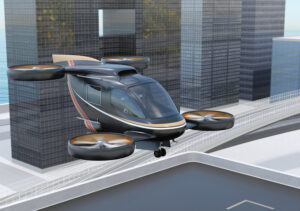 By Kirk McManus
By Kirk McManus
The future of parking is already here. The next generation of parkers and parking entities will involve flying airships, driverless automobiles, a phone app, a web browser, and a car charger. Lift Aircraft already has an FAA-approved, single seat flying airship. A person with a backpack or purse can fly themselves to their next destination. The airship has no doors or windows and maybe not a heater or air conditioner, but when the model T first originated it didn’t have air conditioning, GPS, a radio or heated seats. It only takes an hour of training to begin flying back and forth to work. Eventually flying airships will have the same safety and comfort features as the modern automobile.
The arrival of airships completely changes the parking paradigm. Parking garages and parking lots will have to be redesigned or renovated to make room for flying airships. Airships driverless vehicles and vehicles will use the same parking spaces.
Typically when an entry lane or exit lane of a parking garage or parking lot and the gate arm won’t raise, the driver presses an intercom button or a screen to get assistance. But what happens in a driverless car when there is no driver to press a button for help? What happens when the driverless car is disabled in the entry or exit lane?
A driverless car simply returns to its point of origin or parks elsewhere, most likely in a free parking stall. (Return to Origin or Park Elsewhere—ROPE). This frees up more parking spaces for more vehicles in payment stalls and fills up free parking stalls faster. It also reduces revenue to the parking provider since the driverless car doesn’t pay to park.
An airship can’t be booted and may be require a larger tow truck or towing airship The airship must be chained and locked to the ground or other surface object to prevent takeoff.
The technology in a driverless car must be able to detect a gate arm when entering or exiting a parking garage or lot. Whatever frequencies a driverless vehicle or airship uses to navigate must not interfere with the frequencies used in raising gate arms or counting parking stalls. A driverless car can’t insert a credit card or debit card to pay on exit, print out a ticket upon entry, and pull a receipt at an exit lane either. A flying airship can’t easily stop at an entry lane to pull a ticket, print a bar code ticket or insert a credit or debit card to enter or exit a parking area.
Accommodations must be made so that flying airships can take off and land. Flying airships, driverless vehicles and standard vehicles will all be in the mix, making parking a challenge and with many opportunities for growth!
The future is here. We can start now to prepare by installing conduits and infrastructure and electric services for future growth. Installing airport lighting on top light poles, parking garages and our facilities so the infrastructure is there before the flying airship arrives.
Conduit can be installed underground to make room for future expansion. Parking garages will need higher ceiling heights and larger entrances and exits to allow for airships to enter and exit. A decision may need to be made as to how old a passenger can be in a driverless vehicle in case the driverless vehicle becomes inoperative or in an accident. Typically, technology evolves faster than safety policy, or public policy.
What a great time it is to be in parking. As we look to the future we’ll need more technology experts, GIS experts, and happy faces at the customer service counter to keep our customers happy!
Kirk McManus is a parking and transit service repair technician at the University of Nebraska.
